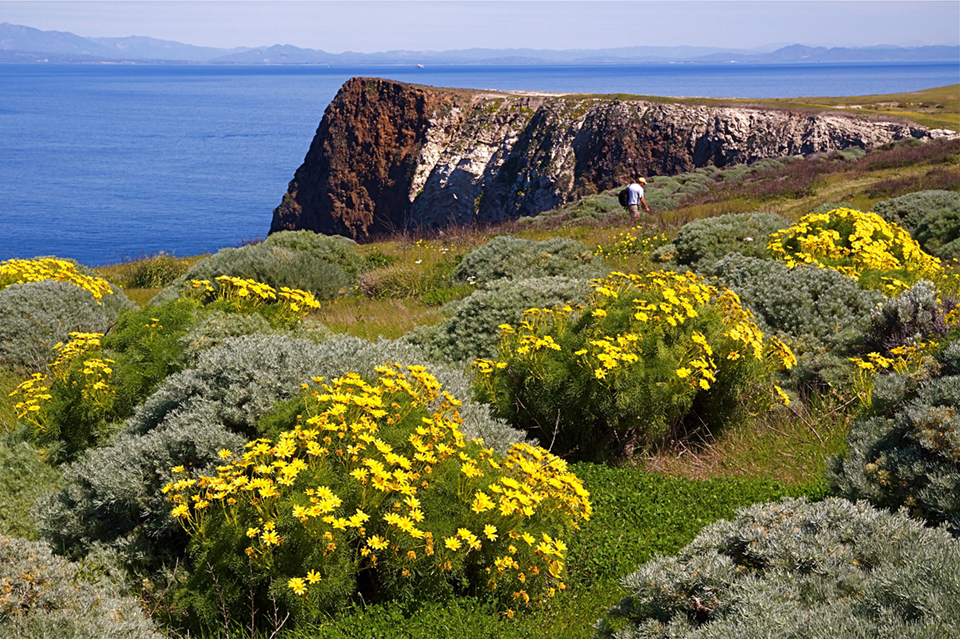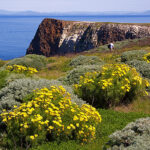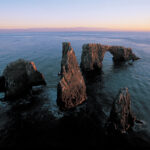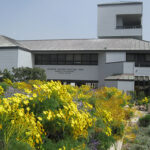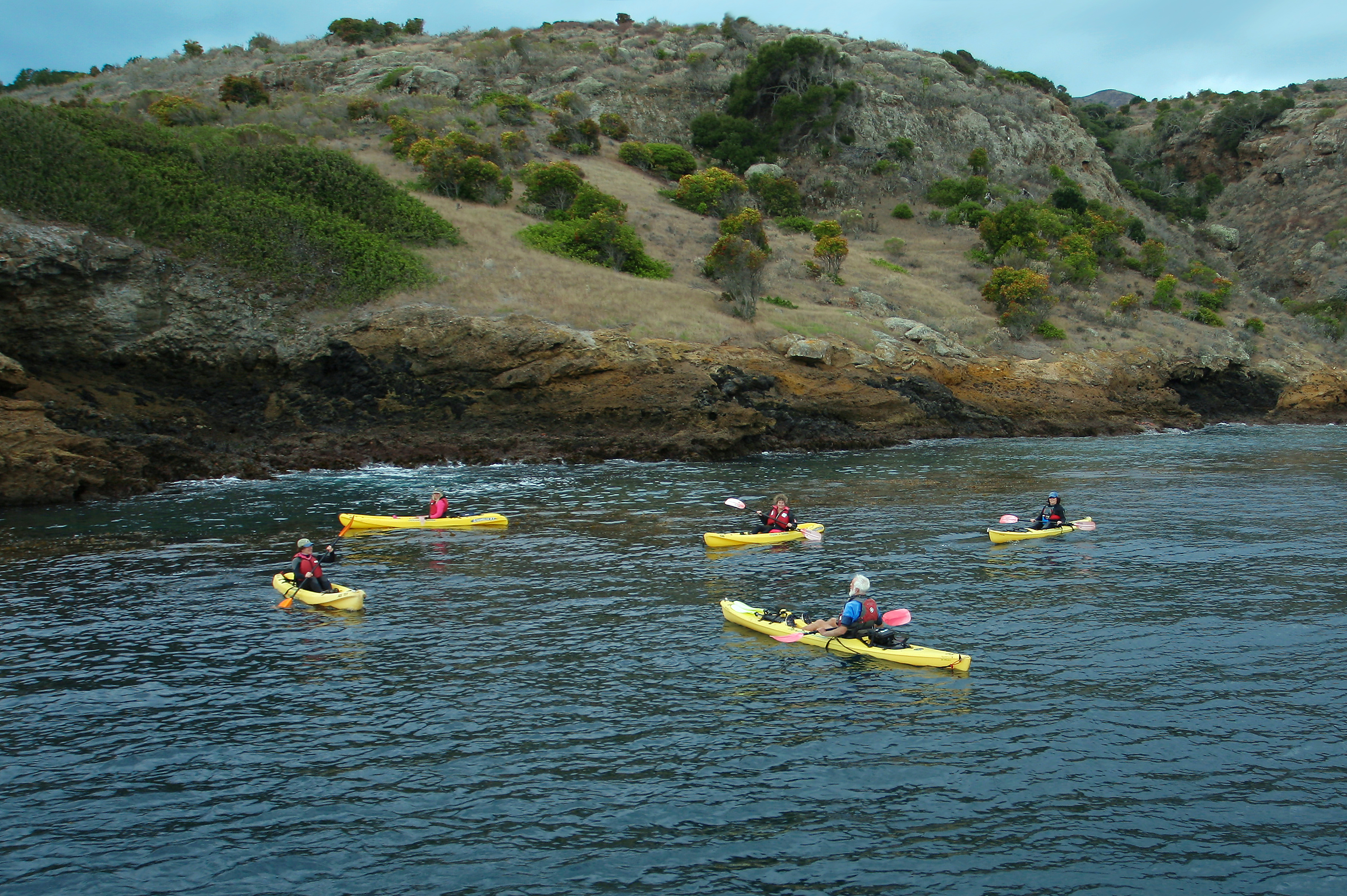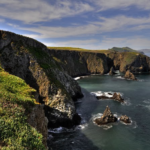The Channel Islands National Park, referred to as “The American Galapagos,” encompasses five remarkable and remote islands right off the Ventura coast: Anacapa, Santa Cruz, Santa Rosa, San Miguel and Santa Barbara. The Channel Islands and encircling waters are home to over 2,000 plants and animals, of which 145
are found nowhere else in the world including the Island Fox. Established as a National Park in 1980, each of the islands is a fascinating world unto itself. World class diving, hiking, kayaking, sea cave exploration, photography, snorkeling, camping, wildlife and wildflower viewing, the Channel Islands offers uninterrupted time with family and friends while relaxing to the soothing sounds of the natural world.
Channel Islands National Park Website



The Robert J. Lagomarsino Channel Islands National Park Visitors Center
Free Admission
Open 7 Days a Week. Free parking at Harbor Cove Beach on Spinnaker Drive.
The Channel Islands National Park Visitor Center features a bookstore, gift items, live tidal pool with daily talks, viewing tower, and exhibits featuring the unique character of each park island. The viewing tower offers one of the best views of Ventura Harbor, the Channel Islands, and the Ventura coastline.
Visitors can enjoy the newly released high-definition 25-minute movie entitled, “Treasure in the Sea”, narrated by Kevin Costner.
View Transcript
00:58
Out on the horizon,
01:00
a distant world shimmers.
01:08
Five islands and the seas around them.
01:13
A wilderness protected by wind and waves.
01:21
It is a place of solitude and adventure.
01:32
A glimpse of what California used to be.
01:39
Out past the edge of the continent,
01:41
out on the edge of the imagination, this lost world beckons.
02:08
Off the coast of southern California lie a group of islands cloaked in mist.
02:13
Channel Islands National Park.
02:16
It’s just a short boat ride from one of the most populated regions on Earth.
02:20
But few travel here, out where the mainland ends.
02:25
Those who do
02:26
find a remarkable refuge. Half land,
02:30
half water.
02:32
Isolated, but overflowing with life.
02:39
Five islands and the sea that guards them.
02:45
Anacapa,
02:47
jutting out of the sea. Craggy and volcanic
02:55
with its iconic Arch Rock,
02:58
the historic lighthouse,
03:03
and wildflowers that bring the rocky soil to life.
03:12
Santa Cruz,
03:13
the largest and most of diverse of them all. A rough, mountainous island cut by a massive fault line.
03:23
Home to nearly 60 plants and animals found nowhere else on Earth.
03:28
And for the many visitors who come from the mainland,
03:31
it is an island playground.
03:40
Santa Rosa,
03:44
a landscape that rolls from the mountains to the marshes,
03:48
sheltering rare Torrey Pines,
03:51
weathered sandstone canyons,
03:54
and vestiges of a ranching past.
04:01
04:05
San Miguel,
04:06
an island of extremes.
04:11
Wild, windy, and remote,
04:13
where isolated beaches protect one of the largest rookeriess
04:16
of seals and sea lions in the world.
04:19
And ancient dunes reveal the caliche forest,
04:23
fossilized trees from long ago.
04:33
Santa Barbara, the tiny tableland.
04:42
A mesa framed by twin peaks, and steep rock faces.
04:49
Where stunning wildflowers and nesting seabirds draw the occasional visitor from the distant mainland.
04:57
And all around,
04:58
an underwater national park.
05:01
A mile of sea on the fringes of the land.
05:07
One of the planet’s great marine ecosystems,
05:11
flowing with life.
05:39
Harsh and lonely.
05:42
There is nothing easy about life on these islands,
05:46
yet people have been drawn here for over 13,000 years.
05:51
Some of the oldest human remains known in North America
05:54
were discovered here.
05:58
The native Chumash people were one of the
06:00
most advanced societies of their time.
06:06
They developed a complex society,
06:10
trading with the mainland in plank canoes, and using shell beads for money.
06:17
For thousands of years, they flourished.
06:20
Then, in 1542, the Spaniards arrived
06:24
led by explorer
06:25
Juan Rodríguez Cabrillo.
06:28
But the meeting of European
06:29
and native cultures
06:30
would be tragic.
06:32
The Chumash were exposed to new diseases, like the measles and smallpox ,
06:37
that devastated their populations.
06:40
By the mid- 1800s, the Chumash were forced from their island homes
06:44
and into missions along the coast.
06:48
Despite these hardships,
06:49
the Chumash people have never given up their connection to this island homeland.
06:55
In time, others would come,
06:57
drawn by the rich resources:
06:59
Otter hunters, fishermen,
07:02
sheep and cattle ranchers.
07:07
Some manned the islands as military outposts.
07:13
Others ran the beacons to guide vessels through hazardous seas.
07:19
Over the years, the reasons for valuing these islands changed.
07:24
A new approach to stewardship would emerge,
07:27
to restore and protect them,
07:30
creating a national park,
07:32
an international biosphere reserve,
07:35
and a national marine sanctuary.
07:38
A place of research and recreation,
07:41
attracting a new type of traveler.
08:03
It’s only an hour from the freeways of southern California,
08:08
but when visitors arrive, they can tell
08:10
this is a different world.
08:14
Millions of people may live less than a hundred miles away,
08:17
but here, you are alone.
08:23
This craggy coastline offers a chance to experience the land the way it once was.
08:29
The original California.
08:37
Female hiker : “Our family goes camping on the
08:38
Channel Islands
08:40
to get away from it all.
08:43
There’s just something about this place. It feels so wild, so remote,
08:51
like you’re in your own world.”
08:55
Narrator: This is the rugged charm of these lonely islands.
08:59
The vistas to be discovered,
09:03
the journeys waiting to be undertaken.
09:08
It’s a place of jagged beauty
09:13
where calm restores the spirit.
09:17
A quiet corner of the world.
09:42
Despite their closeness to the coast,
09:44
these islands have never been connected to the mainland.
09:48
This isolation has fostered the development of plants and animals that
09:51
09:52
exist nowhere else on the planet.
09:56
Nearly 150 unique species of flora and fauna.
10:02
Like the island fox,
10:04
one of the rarest mammals in North America.
10:09
The Torrey pines and the island oak,
10:12
some of the most distinctive trees in the world.
10:16
And the island scrub-jay,
10:18
found only on Santa Cruz Island.
10:23
These isolated Channel
10:24
Islands have been their refuge,
10:27
with miles of ocean to protect them,
10:30
strong winds and rough seas to shield them.
10:52
It starts in the waves themselves,
10:54
a rich web of life that reaches up from the sea.
10:58
Here, the cold currents of the north Pacific collide with
11:01
the warm waters of the south,
11:04
and combined with a great upwelling of nutrients from the ocean floor.
11:09
A living soup develops that supports more than 2,000 species
11:13
from tiny plankton,
11:15
to giant whales.
11:27
It’s one of the most diverse marine environments on Earth.
11:51
No wonder divers and swimmers from all over the world come here.
11:56
It’s like swimming in a great aquarium.
12:11
Others come looking for adventure along the coast,
12:14
to explore some of the largest sea caves on Earth,
12:17
the rock cathedrals,
12:19
where the ceilings soar.
12:23
Kayaker: “They call this the Painted Cave .
12:26
It’s here on the edge of Santa Cruz Island.
12:31
It’s an incredible setting.
12:34
Paddling through the water here lets me experience
12:37
the park in a completely different way.
12:39
I become immersed in the sea,
12:42
intimate with the coastline and the marine life.”
12:53
Narrator: Life flourishes at the boundary between land and sea,
12:57
where tidepools
12:57
support a rich tapestry of life.
13:02
It’s a place between two worlds, half land, half liquid,
13:08
battered by the waves
13:12
and baked by the sun. It’s a world of extremes.
13:21
And those who come to visit find an entire universe at their feet.
13:43
This land -sea connection provides a refuge for birds as well.
13:47
They arrive in large numbers,
13:49
drawn by the isolation,
13:51
the lack of predators, and the food.
13:55
For thousands of sea birds traveling the Pacific,
13:58
these little pieces of land are key for survival.
14:02
Year after year, they come to breed,
14:05
to nest in secluded rookeries.
14:08
Pelicans and cormorants,
14:12
oystercatchers and western gulls.
14:16
This abundance of wildlife doesn’t just make these islands an enjoyable place to visit.
14:20
14:21
For scientists,
14:22
it’s a living laboratory,
14:24
a place to see how a small fragile pool species
14:28
can change and adapt.
14:30
And in this laboratory,
14:32
research is under way
14:34
in the giant kelp forest.
14:38
This is not just any seaweed.
14:41
This is a great rainforest beneath the waves.
14:45
Giant kelp is one of the fastest growing plants on Earth,
14:49
growing up to two feet a day.
14:54
Below the surface, light plays through these great strands like shafts of sunlight through stained glass.
15:01
But a quiet crisis is brewing here.
15:05
Many of the magnificent animals in the kelp forest
15:07
have disappeared, as a result of overfishing
15:10
and a changing environment.
15:13
Since the 1980s, teams of researchers have been diving here
15:16
to monitor the undersea life
15:18
and track exactly how it’s doing.
15:23
Female Scientist: “Some creatures, like the abalone, were prevalent just a few decades ago.
15:27
but now, they’re rare.
15:29
That’s why this work is so important. To protect the ecosystem, you have
15:33
pay attention. You have to know its health.
15:36
That’s why we’re so committed to this work.”
15:42
Narrator: This is all part of the longest running monitoring program in the national parks,
15:47
the model many others are based on.
15:50
Because this data is so extensive,
15:53
it was used to help establish marine reserves,
15:56
underwater refuges closed to fishing.
15:59
And the results are encouraging. There are now more fish, and bigger fish,
16:04
in these reserves.
16:06
For all the changes these submarine forests continue to harbor
16:10
a remarkable range of underwater life,
16:13
nearly a thousand species of plants and animals.
16:22
Scientists have also been documenting an amazing story of recovery and renewal
16:26
in one of the most isolated regions of the park.
16:30
San Miguel Island.
16:32
It is something that could have only occurred in a place as remote
16:35
and protected as this.
16:38
It was here that the northern elephant seal was hunted
16:42
to near extinction less than a century ago.
16:45
Today, however, things are different.
16:51
It is one of the world’s great wildlife displays.
16:54
Tens of thousands of seals and sea lions are coming ashore, as they do each year.
17:00
The world’s largest congregation of northern elephant seals, northern fur seals, harbor seals, and California sea lions all haul up on these sandy beaches to breed, pup, and molt.
17:17
Scientists will occasionally venture into the rookery to study their behavior
17:21
and monitor their health.
17:26
Scientist: “It’s been pretty awesome
17:27
to witness this steady population increase for three decades.
17:41
It’s a fairly uplifting thing because we’ve
17:43
also been studying other animals
17:45
that have been added to the endangered species list.
17:48
So it’s been pretty wonderful to watch this.
17:53
Narrator: There aren’t many places left in North America like this,
17:56
places secluded and inaccessible,
17:59
places that these animals can call home.
18:03
Scientist: “There’s been a tremendous value of having
18:06
these islands protected,
18:08
remote, even though we’ve got fifteen million people less
18:12
than a hundred miles away.
18:13
The fact that these habitats were here
18:15
is the key factor
18:18
in their population success and recovery.”
18:36
Narrator: Our national parks protect places like the Channel Islands,
18:40
offering a new approach to managing this fragile ecosystem,
18:44
one that is still recovering
18:45
from the unintended consequences of an earlier era.
18:50
Like the introduction of non-native animals,
18:52
which altered the islands,
18:54
devastating native plants and animals.
18:58
Over time, these non-native species have been removed,
19:02
and in just a few decades,
19:04
the islands have begun to turn a corner.
19:08
Signs of recovery can be seen
19:10
on islands from Santa Barbara to San Miguel.
19:15
Two of the great success stories are the recovery of island foxes
19:18
and bald eagles.
19:21
Not long ago, the island fox was on the brink of extinction,
19:26
with only 14 left on Santa Rosa,
19:27
and 15 on San Miguel.
19:30
And bald eagles had disappeared from the Channel Islands altogether.
19:35
Then a program to re-establish both species gradually rebuilt their populations.
19:41
Now both species are back from the edge of extinction
19:44
and out in the wild again. And they are not alone.
19:50
The once endangered northern elephant seals, California brown pelicans, peregrine falcons,
19:58
and island plant communities are all recovering
20:00
in this protected habitat as well.
20:04
The National Park Service is also studying and preserving important vestiges of our past,
20:08
20:09
to provide a greater understanding
20:11
of how people have adapted to these islands
20:13
for over 13,000 years.
20:17
From the long and unique tradition of island ranching,
20:20
to the shipwrecks
20:21
that reveal a maritime heritage,
20:24
to the earliest traces of the first island people.
20:27
All are preserved by this national park.
20:32
And today, those who trace their heritage to the islands
20:36
20:37
still feel the pull of this place.
20:39
Native Chumash Woman: “Our ancestors came from these islands,
20:42
and each time we come back, we can feel their presence here.
20:46
We walk in their same footsteps through this unspoiled natural landscape.
20:52
It’s wonderful to know that our children will be able to come back
20:56
and know the beauty and significance of this place.”
21:23
Narrator: And so today, the Channel Islands beckon us.
21:28
175 miles of untouched coastline.
21:34
The opportunity to see a vibrant world
21:36
teeming with life.
21:40
To make sure it stays that way
21:42
is a mission that continues.
21:45
To hold this land in trust for the generations to follow.
21:50
This is the calling of Channel Islands National Park.
21:59
For all, a place to study and cherish,
22:02
a place to experience and enjoy,
22:05
a place to conserve.
22:08
Out past the edge of the continent, it waits,
22:11
guarded by the wind and the waves,
22:14
this island world, a wilderness shimmering on the horizon.
22:36
22:45
23:30
23:34
New Ways to Visit Channel Islands National Park
Check out the Channel Islands National Park digital app to enhance the visitor experience in the park that can also be used to take a virtual visit. The new mobile app is free and available at the App Store or on Google Play.
Features in the app include exploring the islands through stories, sites, self-guided tours, and interactive maps, or finding favorite places, trails, and topics of interest. Visitors can use the app to create a collage of the images from your visit or to track a calendar of current conditions, events, or ranger programs. The app is fully accessible with audio description and alternative text for images. To learn more go to NPS Channel Islands App.

Getting To The Islands And Camping

Photo by Dan Harding
Island Packers, the official concessionaire to the Channel Islands National Park, offers both landing and non-landing trips to all five islands. Landing trips provide the perfect setting for island hiking, camping, and kayaking. Non-landing trips include whale watching into the waters of the Santa Barbara Channel and the Channel Islands National Marine Sanctuary to view the larger of the marine mammals, the Pacific Gray Whales and Humpback and Blue Whales. In addition, Island Packers also offers Wildlife Cruises featuring a three-hour narrated tour along the rugged north shore of Anacapa or Santa Cruz Island with highlights including sightings of sea lions, seals, and island birds.
For information, pricing, and reservations visit www.islandpackers.com
Camping in the Channel Islands National Park Reservations: www.recreation/gov
Camping Permits: 877.444.6777
World Class Diving
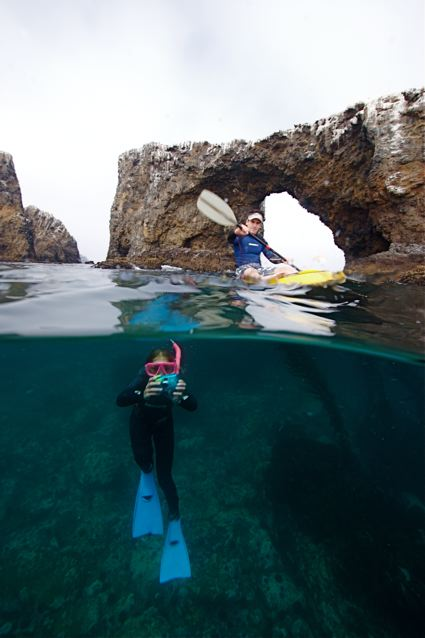
Photo by Dan Harding
The Channel Islands National Park and Marine Sanctuary offers world-class diving options. Lush with kelp forests and teaming with marine life, diving at the Channel Islands – Santa Cruz and Anacapa Islands are very accessible from the Ventura Coast out of Ventura Harbor. Ventura Dive & Sport offers dive lessons and dive rentals on site at Ventura Harbor Village. Several options are available from overnight boat trips to day dives. A variety of dining options await you at Ventura Harbor upon return. Overnight at Four Points by Sheraton or Holiday Inn Express and Suites in the Ventura Harbor before or after your dive trip.
www.peaceboat.com
www.raptordive.com
www.calboatdiving.com
www.venturadive.com
Kayak Trips

Photo by Doug Mangum
Channel Islands Kayak Center arranges kayak tours or rentals to the Channel Islands, and is located next to Islands Packers in the Ventura Harbor. Join a kayak sea caving tour, or rentals include easy to use sit-on-top ocean going kayaks, a full safety briefing, map of the island caves and up-to-date weather information before your trip. For reservation information visit www.cikayak.com.
Marine Sanctuary

Channel Islands National Marine Sanctuary encompasses 1,470 square miles of the ocean environment surrounding five of the eight California Channel Islands – Anacapa, Santa Cruz, Santa Rosa, San Miguel and Santa Barbara. . Beautiful waters and pristine anchorages also make the sanctuary a popular year-round destination for recreational boaters and kayakers. Chartered sailing adventures are available out of Channel Islands Harbor and guided kayaking trips as well as rentals are available through the Channel Islands National Park’s visitor services page. SCUBA divers can enjoy word class dive sites and even view some of the protected wrecks within the sanctuary – check with local dive vessels for available trips and remember to please look but don’t touch. The sanctuary is also a popular destination for recreational fishing, with many chartered trips available out of local harbors. Know before you go: the sanctuary also has a network of Marine Protected Areas with 11 marine reserves that prohibit all fishing activities, and two marine conservation areas that allow limited take of lobster and pelagic fish.
